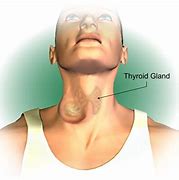Thyroid cancer is a relatively rare form of cancer that affects the thyroid gland, located in the front of the neck. One of the primary signs of thyroid cancer is the presence of a lump or nodule in the thyroid gland. In this article, we will discuss the characteristics of a thyroid cancer lump and how it can be detected.
Characteristics of a Thyroid Cancer Lump
- Location: Thyroid cancer lumps typically develop in the thyroid gland, which is located in the lower front of the neck. The thyroid gland is butterfly-shaped and sits below the Adam’s apple.
- Size: Thyroid cancer lumps can vary in size. They may be small and undetectable by touch (less than 1 centimeter), or they can grow larger and become palpable or visible.
- Texture: The texture of a thyroid cancer lump can vary depending on the type of cancer. Some lumps may feel hard, while others can be soft or rubbery. It is important to note that not all thyroid nodules or lumps are cancerous, and the texture alone cannot determine the presence of cancer.
- Mobility: Thyroid cancer lumps are typically fixed in place and do not move easily when touched or swallowed. Non-cancerous nodules, on the other hand, may be more mobile.
Detection of a Thyroid Cancer Lump
- Self-Examination: Self-examination can be helpful in detecting thyroid nodules or lumps. Stand in front of a mirror and tilt your head back to expose the neck. Look for any visible swelling or asymmetry in the lower neck area. Gently palpate the thyroid gland using your fingers to check for any lumps or irregularities. If you notice anything unusual, it is important to consult with a healthcare professional for further evaluation.
- Medical Examination: If you visit a healthcare professional with concerns about a potential thyroid lump, they will perform a physical examination. They may palpate your neck to feel for any nodules or lumps and assess their characteristics. The healthcare professional may also ask about any accompanying symptoms, such as difficulty swallowing or changes in voice.
- Diagnostic Tests: To further evaluate a thyroid lump, additional diagnostic tests may be recommended. These can include:
- Ultrasound: An ultrasound uses sound waves to create an image of the thyroid gland, helping to determine the size, shape, and characteristics of the lump.
- Fine-Needle Aspiration (FNA) Biopsy: A biopsy involves the removal of a small sample of cells from the lump for examination under a microscope. This helps to determine if the lump is cancerous or benign.
- Blood Tests: Blood tests, such as measuring thyroid hormone levels or thyroid stimulating hormone (TSH), may be conducted to assess thyroid function and provide further insights.
Conclusion
A thyroid cancer lump is typically characterized by its location in the thyroid gland, variable size, texture, and fixed position. Detecting a thyroid lump can involve self-examination, medical evaluation, and potentially diagnostic tests such as ultrasound and biopsy. It is important to remember that not all thyroid nodules are cancerous, and further evaluation by healthcare professionals is necessary to determine the nature of the lump. If you suspect the presence of a thyroid lump or have any concerns, it is crucial to consult with a healthcare professional who can provide proper evaluation, diagnosis, and guidance.

